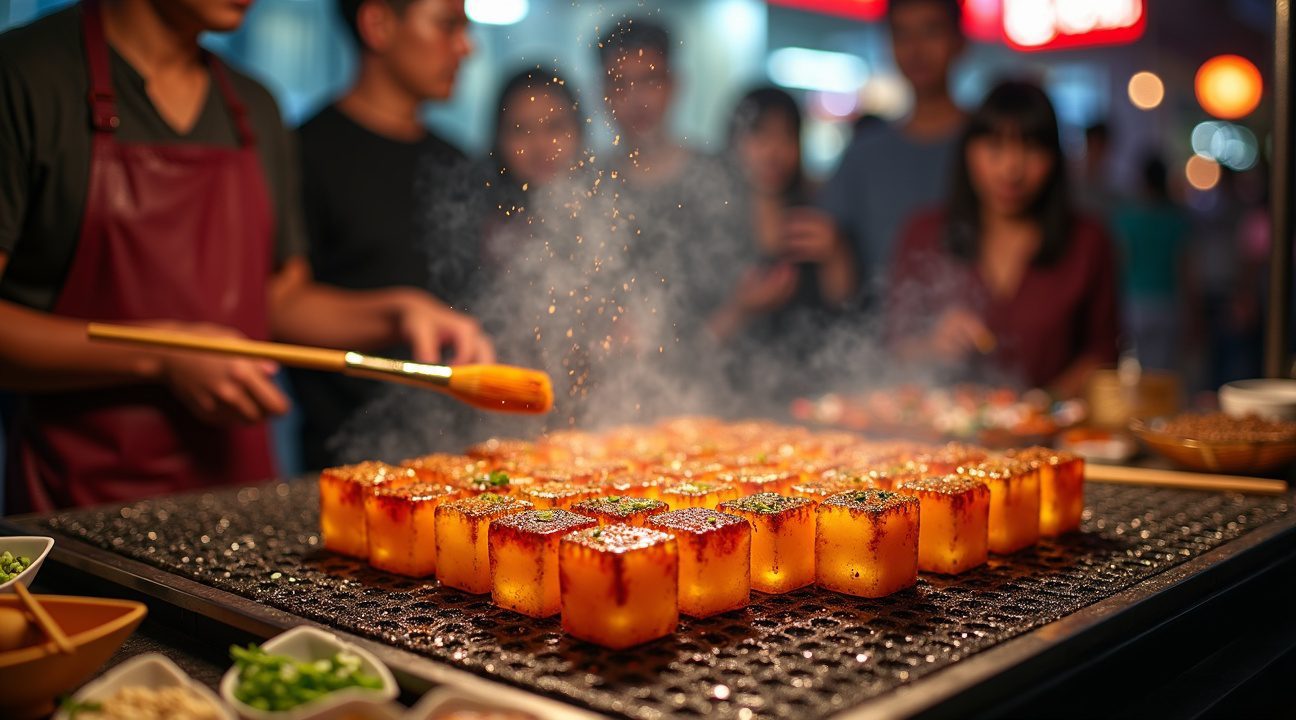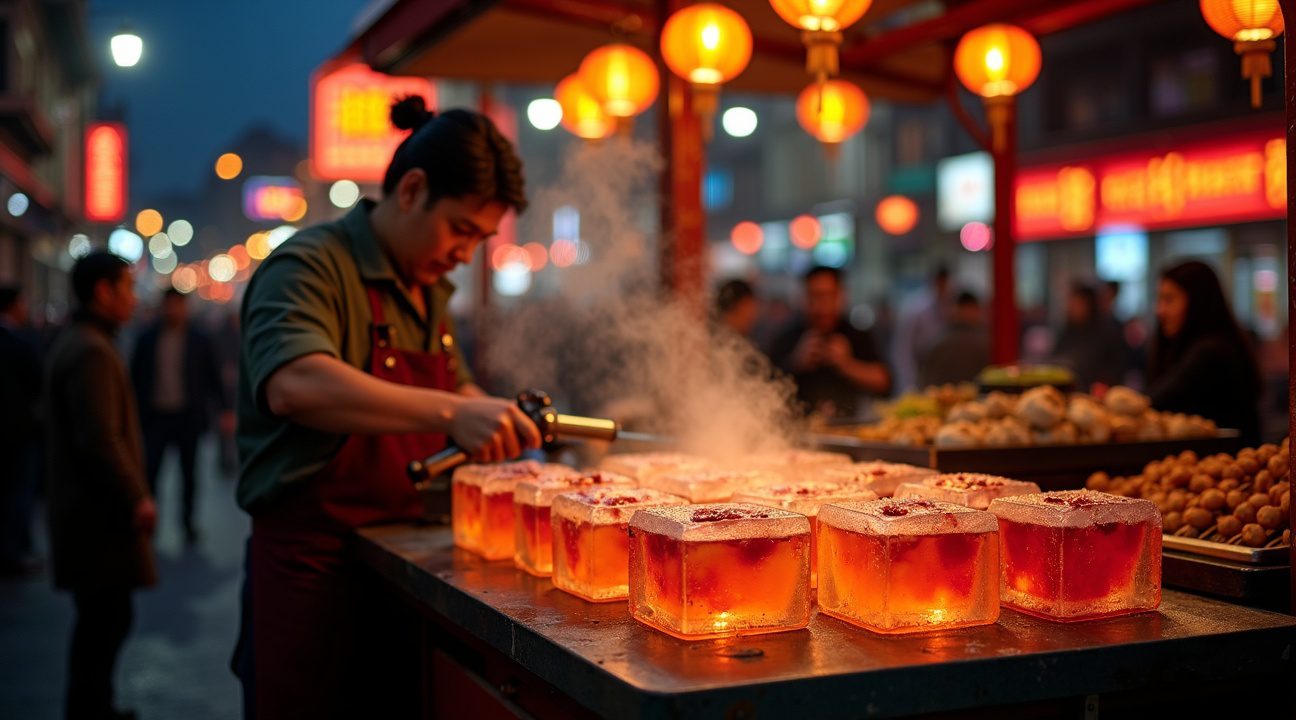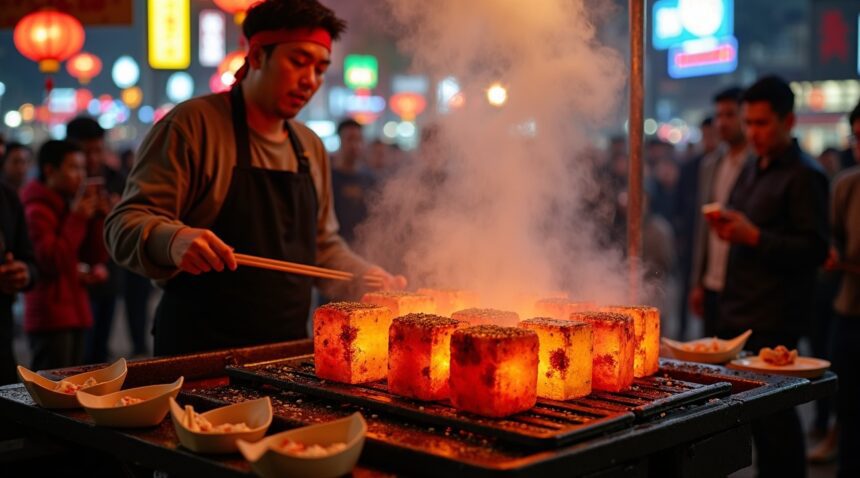China’s latest viral street food trend of grilling ice cubes represents a fascinating blend of modern social media spectacle and ancient culinary traditions that prioritize sensory experience over conventional consumption.
This unusual delicacy combines the theatrical drama of sizzling ice with complex spice blends. The trend has exploded across Chinese night markets and social media platforms, challenging traditional notions of what constitutes food.
Key Takeaways
- Street vendors coat ice cubes in oil and season them with traditional Chinese barbecue spices including chili powder, cumin, scallions, and coriander before grilling them for approximately $2 USD per serving.
- The trend connects to ancient Chinese practices like “Suodiu” where people flavored inedible objects such as river stones for taste experiences rather than nutritional consumption.
- Social media virality drives commercial success as vendors capitalize on the novelty factor and Instagram-worthy content creation rather than culinary satisfaction.
- Origin stories claiming Northeast China or ancient Hubei traditions lack historical verification with food historians finding no documented evidence supporting these marketing claims.
- The practice challenges food boundaries by creating contradictory sensory experiences that combine spicy coatings with frozen cores, appealing to consumers seeking unusual culinary adventures.
Learn more about the sensory appeal of unconventional cuisine and its cultural significance through this detailed Atlas Obscura article on grilled ice.
China’s Latest Street Food Goes Viral: Ice Cubes on the Grill
Social media platforms have exploded with videos of street vendors grilling ice cubes, creating one of China’s most unusual food trends. I’ve observed this phenomenon spreading rapidly across platforms like TikTok and Weibo, where users share clips primarily for their shock value and entertainment factor. The absurdity of placing frozen water on hot grills has captured global attention, generating millions of views and sparking countless debates about modern food culture.
Night markets in Chinese cities have embraced this bizarre trend, with Changsha in Hunan Province leading the charge. I’ve seen vendors setting up specialized grilling stations where they place ordinary ice cubes on hot metal surfaces, watching them sizzle and steam dramatically. The theatrical element creates an immediate spectacle that draws curious crowds and generates perfect content for social media sharing.
The Economics Behind the Gimmick
Street vendors have quickly recognized the profit potential in this unconventional offering. I notice they’re capitalizing on pure curiosity rather than culinary satisfaction, charging premium prices for what essentially amounts to expensive water. Several factors contribute to the trend’s commercial success:
- The novelty factor attracts customers willing to pay for the experience
- Social media content creation drives repeat visits and word-of-mouth marketing
- Low ingredient costs maximize profit margins
- The theatrical preparation process entertains waiting customers
Consumer reactions reveal the divided nature of this trend. I’ve observed that many purchasers acknowledge they’re buying into a gimmick rather than expecting genuine flavor enhancement. The ice cubes essentially melt on contact with the grill, creating steam and leaving behind slightly warmed water with minimal taste alteration. Critics argue the practice represents style over substance, questioning whether paying inflated prices for grilled ice constitutes reasonable value.
The phenomenon has sparked interesting discussions about modern consumer behavior and social media influence on food choices. I see this trend as emblematic of how viral content can drive purchasing decisions beyond traditional considerations of taste, nutrition, or value. Unusual phenomena in China often capture international attention, and grilled ice cubes represent another example of how unique cultural moments spread globally through digital platforms.
Despite widespread skepticism about its culinary merit, the grilled ice cube trend continues gaining momentum across Chinese night markets. Vendors report steady sales driven by customers seeking Instagram-worthy content and novel experiences, proving that sometimes entertainment value outweighs traditional food expectations in modern street food culture.
https://www.youtube.com/watch?v=gBVTS5E1tDo
How Vendors Actually Prepare Ice Cubes for Grilling
I’ve discovered that street vendors across China have developed a surprisingly methodical approach to preparing grilled ice cubes that keeps customers coming back for more. The process begins with coating regular ice cubes in a thin layer of oil, which serves as a crucial barrier that slows down the melting process when the cubes hit the hot grill surface.
The Seasoning and Grilling Process
Vendors don’t simply toss plain ice onto their grills. Instead, they carefully season each cube with an aromatic blend of spices that mirrors traditional Chinese barbecue flavors. The typical seasoning mix includes:
- Chili powder for heat
- Ground cumin for earthiness
- Freshly chopped scallions for brightness
- Coriander for a citrusy note
Additional garnishes vary by vendor, but many include:
- Sesame seeds
- Garlic powder
- Five-spice blends
Once seasoned, the oil-coated ice cubes go directly onto the grill grates. The oil creates a sizzling effect while preventing the ice from melting too rapidly, giving vendors enough time to apply additional layers of flavor. Many operators brush the grilling ice with barbecue sauce or other liquid seasonings, creating a complex flavor profile that combines smoky, spicy, and savory elements.
Serving and Pricing
For approximately $2 USD (roughly 16 yuan per serving), customers receive a small portion of these uniquely prepared ice cubes. Vendors present the grilled ice on small plates or in paper boats, similar to how they serve other street foods. The presentation mirrors traditional Chinese barbecue styling, complete with wooden chopsticks for eating.
Customers use the provided chopsticks to pick up individual pieces, eating them just like they would consume grilled meat skewers or other hot street foods. This eating method adds to the novelty factor and helps maintain the illusion that they’re consuming a legitimate grilled delicacy rather than flavored ice.
The entire preparation process typically takes just a few minutes from start to finish, making it an efficient option for busy street vendors looking to offer something unique. While this trend might seem unusual to outsiders, it demonstrates how creative food entrepreneurs can transform even the most basic ingredients into profitable novelties. The combination of theatrical preparation, familiar flavors, and affordable pricing has made grilled ice cubes a memorable experience for curious food enthusiasts willing to try China’s more unusual culinary offerings.

The Contradictory Appeal of Spicy Ice
China’s grilled ice cubes present a fascinating paradox that challenges conventional understanding of what constitutes food. This unusual creation deliberately embraces contradiction, offering consumers a spicy sensation while maintaining an icy core temperature that defies logic.
Breaking Traditional Food Boundaries
The appeal lies precisely in its impossible nature. Vendors market these frozen treats as both fiery and frigid, creating an experience that confuses taste buds and expectations simultaneously. I find this contradiction particularly intriguing because it forces people to reconsider their assumptions about temperature and flavor combinations. The spicy coating somehow coexists with the ice’s natural coldness, producing a sensory experience that shouldn’t work but somehow does.
Late-night food markets have embraced this novelty, with vendors targeting adventurous eaters who crave unusual experiences. The treat has gained popularity among those who want something different from traditional street food options. China’s appetite for unusual phenomena extends beyond weather events into culinary experimentation.
The Food Debate
Marketing emphasizes the low-fat nature of grilled ice, positioning it as a guilt-free indulgence. Vendors promote it as containing virtually no calories while still providing the satisfaction of consuming something flavorful. This nutritional angle appeals to health-conscious consumers who want to participate in the trend without compromising their dietary goals.
However, food critics and nutritionists question whether grilled ice qualifies as actual food. The debate centers on whether flavored ice can provide any meaningful sustenance beyond momentary taste satisfaction. Some argue that calling it food stretches the definition too far, while supporters claim that any edible item that provides flavor and experience deserves the classification.
The controversy extends to practical concerns about consumption. Critics wonder about the logistics of eating something that’s simultaneously hot on the outside and frozen on the inside. They question whether the spicy coating can maintain its heat long enough to create the promised contradictory experience, or if it simply melts away before reaching the consumer’s mouth.
Despite these debates, the popularity continues among those seeking Instagram-worthy food experiences and genuine culinary adventures. The grilled ice phenomenon represents China’s willingness to push food boundaries, even when the result challenges basic assumptions about what makes sense to eat.
Disputed Origins: Northeast China vs. Ancient Traditions
Street vendors across China’s major cities boldly claim grilled ice cubes originated in Northeast China, particularly in provinces like Heilongjiang and Jilin. These sellers craft elaborate stories about how harsh winters forced residents to develop creative ways to prepare frozen treats over open flames. They describe generations of families passing down techniques for achieving the perfect char on crystallized water.
Local government officials in Northeast China vehemently reject these marketing claims. They argue that no authentic regional cuisine includes grilled ice cubes, and street vendors fabricate these origin stories to inflate prices and attract curious tourists. Municipal food safety inspectors have found no documentation supporting the practice as a legitimate northeastern specialty.
Media Claims and Historical Gaps
Several Chinese media outlets have attempted to trace the snack’s roots to Hubei province in central China. These reports suggest ancient practices dating back centuries, where villagers allegedly grilled ice during particularly harsh winters as a survival technique. The stories describe elaborate rituals where families would gather around fires to prepare these frozen delicacies during festivals.
Historical verification remains elusive for these ancient practice claims. Food historians and cultural researchers have found no concrete evidence in historical texts, archaeological records, or documented culinary traditions that support grilled ice consumption in any Chinese province. Academic institutions specializing in Chinese culinary history express skepticism about these purported ancient origins.
The lack of verified historical data creates significant doubt about authenticity claims from both regions. Neither Northeast China nor Hubei province can produce documentation, artifacts, or consistent oral traditions that substantiate their respective origin stories. This absence of proof suggests the practice emerged recently as a modern novelty rather than an authentic traditional food.
Contemporary food bloggers and social media influencers have amplified these disputed origin stories without conducting proper fact-checking. Their posts often blend legitimate regional specialties with fabricated histories, creating confusion among consumers about what constitutes authentic Chinese cuisine. Unusual phenomena in China frequently capture public attention, but distinguishing fact from fiction requires careful investigation.
The commercial motivation behind these origin disputes becomes apparent when examining pricing strategies. Vendors charging premium prices for grilled ice cubes often justify their costs by referencing supposed ancient traditions or regional exclusivity. This marketing tactic exploits consumer interest in authentic cultural experiences while potentially misleading them about the snack’s true background.
Regional tourism boards have distanced themselves from promotional materials featuring grilled ice cubes as traditional specialties. They recognize that promoting unverified culinary claims could damage their credibility and mislead visitors seeking genuine cultural experiences. Instead, they focus marketing efforts on documented traditional foods with established historical provenance.
The controversy highlights broader issues within China’s rapidly evolving street food scene. Vendors frequently invent backstories for novel snacks to differentiate their offerings in competitive markets. While creativity in food preparation deserves recognition, fabricating cultural traditions raises ethical concerns about cultural authenticity and consumer deception.
Food safety regulators have begun scrutinizing vendors who make historical claims about their products. They require documentation for any assertions about traditional preparation methods or regional origins. This increased oversight aims to protect consumers from misleading marketing while preserving the integrity of legitimate cultural food traditions.
The grilled ice cube phenomenon demonstrates how modern social media can rapidly spread unverified information about food trends. Videos and posts featuring dramatic preparation methods attract millions of views, but viral content doesn’t guarantee authenticity. Critical evaluation of sources becomes essential when investigating unusual culinary claims.
Neither Northeast China nor Hubei province has produced credible evidence supporting their respective origin claims for grilled ice cubes. The practice appears to represent a modern novelty rather than an authentic traditional food, despite persistent marketing efforts suggesting otherwise. Consumers should approach such claims with healthy skepticism while appreciating the creativity involved in contemporary street food innovation.
Ancient Chinese Precedent: Stir-Fried Rocks and Suodiu
China’s culinary landscape has long embraced unconventional approaches to food that challenge Western perceptions of what constitutes edible cuisine. Grilled ice cubes find their historical roots in ancient Chinese traditions that involved flavoring inedible objects with aromatic spices and seasonings.
The Traditional Practice of Suodiu
Suodiu represents one of the most fascinating examples of this culinary philosophy. This ancient practice involves stir-frying smooth river stones with carefully selected seasonings, creating flavored rocks that diners suck for taste rather than consume. The stones absorb the complex flavors during the cooking process, allowing people to experience the seasoning without actually eating the solid material.
I’ve observed that Suodiu commands a price of approximately $2.30 USD (16 yuan) in modern Chinese markets. Customers purchase these flavored stones specifically to suck the seasoning from their surfaces before discarding them. This “suck and throw away” approach mirrors the concept behind grilled ice cubes, where the experience centers on flavor extraction rather than traditional consumption.
Historical Context of Flavored Inedibles
Ancient Chinese food culture developed these practices as a way to extend flavor experiences beyond conventional eating. Stir-fried pebbles and similar preparations allowed people to enjoy complex taste profiles while engaging with food in entirely different ways. These traditions demonstrate that Chinese cuisine has always pushed boundaries, finding creative methods to deliver sensory experiences.
The preparation of such items requires specific techniques to ensure proper flavor absorption. Cooks must heat the stones or ice to precise temperatures that allow seasoning penetration without compromising the structural integrity of the base material. This process demands understanding of how different substances interact with heat and spices.
Modern grilled ice cubes continue this lineage of unconventional food experiences. Just as Suodiu transforms ordinary river stones into flavor vehicles, grilled ice cubes convert frozen water into a unique culinary adventure. Both practices share the common thread of creating temporary flavor experiences that exist outside traditional food categories.
These historical precedents help explain why unusual phenomena in China often capture international attention. The country’s willingness to experiment with unconventional food concepts stems from centuries of culinary innovation that prioritized sensory experience over conventional nutritional consumption.
Why Ice Cubes Join China’s Tradition of Inedible Street Snacks
China’s culinary landscape has always embraced unconventional approaches to food experiences, and grilled ice cubes represent the latest evolution in this fascinating tradition. I’ve observed how this trend connects directly to historical practices where riverboatmen and laborers would flavor inedible objects purely for entertainment and sensory experiences rather than nutritional value.
Historical Roots of Unconventional Food Experiences
The practice traces back centuries when Chinese workers, particularly those along major waterways, developed creative ways to enhance mundane experiences during long working hours. Riverboatmen would often experiment with adding flavors to stones, wood chips, and other non-edible materials simply to create interesting taste sensations. These activities served as both entertainment and a way to break the monotony of their daily routines.
This historical context explains why grilled ice cubes don’t seem particularly strange to many Chinese consumers. I find it remarkable how these early practices established a cultural foundation where the boundary between food and entertainment could blur without causing confusion about the item’s actual edibility.
Modern Innovation Within Traditional Frameworks
Contemporary vendors have successfully adapted these age-old concepts to create unique street experiences that attract curious customers. The process involves applying flavored coatings to ice cubes before exposing them to heat, creating dramatic visual effects as the ice transforms while releasing aromatic compounds.
Street food culture in China has always valued spectacle alongside taste, and grilled ice cubes deliver both elements effectively. I’ve noticed how vendors position these offerings alongside traditional snacks, treating them as legitimate components of the street food ecosystem rather than mere novelties.
The popularity demonstrates several key aspects of Chinese consumer behavior:
- An appreciation for experiences that challenge conventional thinking about food preparation
- Valuing entertainment as much as flavor
- Maintaining cultural continuity with historical traditions while embracing modern techniques
Vendors have developed specific preparation methods that maximize both visual impact and flavor delivery. Some use fruit-based coatings that caramelize quickly when exposed to heat, while others incorporate savory elements that create unexpected taste combinations. The brief window between application of heat and complete melting requires precise timing that skilled vendors master through experience.
Unusual phenomena in China often capture public attention, and grilled ice cubes fit perfectly into this category of experiences that blend curiosity with cultural expression.
These inedible street snacks serve multiple purposes beyond simple novelty. They create conversation starters, provide Instagram-worthy moments for social media, and maintain connections to cultural practices that might otherwise disappear. The vendors who specialize in these offerings often become local personalities, known for their theatrical presentation style and creative flavor combinations.

Sources:
Sweet and Savory: “Grilled ice cubes become popular street food trend in Asia”
Food Republic: “Grilled Ice Cubes Are The Latest Trendy Snack Hitting Street Carts In China”
WDBO: “Chinese street vendor goes viral for signature grilled ice cubes dish”
The Straits Times: “China’s edition of girl dinner: Grilled ice cubes seasoned with spices”


